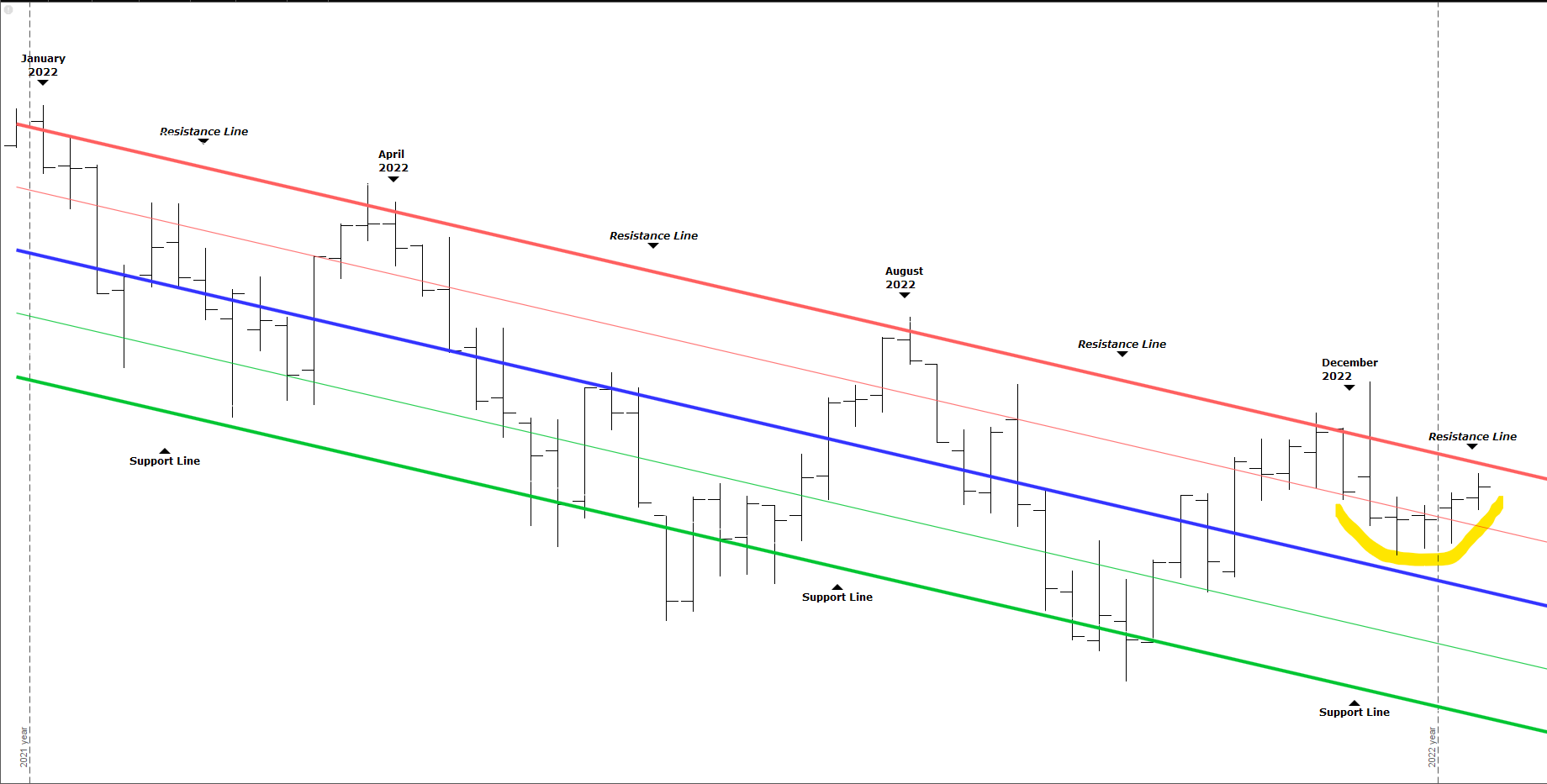
January 10, 2023
Happy New Year!
Previously, in our August 2022 newsletter, I wrote about the descending Zig-Zag Pattern that the market has been in since January 2022. As you can see in the chart below, we are still in this descending channel. The red line on the chart has been resistance, the green line marks support and the blue line marks the center of the channel.

Take a close look at the yellow reversal line on the chart. This is the first time in over a year that the market has turned up and not broken the blue mid-line. This upturn has only been four days and I can’t predict if we will break above the red resistance line, but it is the first time in a year that this has looked slightly promising. Are traders becoming optimistic? While the upturn is encouraging, this week the Bureau of Labor Statistics will report on the Consumer Price Index (CPI) for Year over Year, Month to Month, and the Core CPI report. The Federal Reserve will be taking notice to judge if the interest rate hikes, they have implemented, are slowing the economy to their satisfaction. The results could be very impactful on the markets, up or down. The next FOMC meeting announcement will be on Wednesday, February 1st. Whatever the CPI reports, the Fed Watch Tool is expecting a 76% chance of another ¼ point rate hike. At least the declining rate hike from the last meeting’s ½ point rate hike is encouraging.
The VIX Index closed today at 20.58. On December 1st it was at 20.38. The VIX hit a recent high of 34.88 on September 28. A falling ViX is generally bullish for the markets.
Percent of stocks above their 50-day and 200-day moving average: On 12/1, 90% of stocks were above their 50-day moving average, today 68% are above their 50-day moving average. Last month 62% of the stocks were above their 200-day moving average, today 56% are above their 200-day moving average. These numbers went much lower during the month of December and are rising higher recently, supporting the recent upside momentum.
Federal Reserve: The CME FedWatch Tool is predicting a 79% chance the Federal Reserve will raise interest rates another .25 basis points.
Employment Rate: Total nonfarm payroll employment increased by 223,000 in December, and the unemployment rate edged down to 3.5 percent, the U.S. Bureau of Labor Statistics reported on January 6th. Notable job gains occurred in leisure and hospitality, health care, construction, and social assistance
Inflation Rate: The annual inflation rate for the United States is 7.1% for the 12 months ended November 2022 after rising 7.7% previously, according to U.S. Labor Department data published Dec. 13. The next inflation update is scheduled for release on Jan. 12, 2023, at 8:30 a.m. ET. It will offer the rate of inflation over the 12 months ending December 2022.
The 10-year Treasury index yield: The rate today is at 3.60%. On December 1st it was at 3.62%. The high so far for this year was on January 3rd at 3.81%.
To view past Market Newsletters, go to www.freedomcapitalmanagement.com. On the home page are recent newsletters, for older newsletters go to the blog page tab at the top of the home page.
In this month’s recap: Stocks struggled in December on renewed recession fears.
Monthly Economic Update
![]()
Presented by Guy Woolley, January 2023
U.S. Markets
Stocks were under pressure in December on renewed recession fears and concerns that the Fed may keep rates higher than markets anticipated.
The Dow Jones Industrial Average lost 4.17 percent for the month, while the Standard & Poor’s 500 Index fell 5.90 percent. The tech-heavy Nasdaq composite dropped 8.73 percent.1
A Challenging December
After two solid months of gains, investor sentiment took a u-turn in December. Stocks opened the month lower on new data pointing to economic strength and the loosening of Covid restrictions in China. At one time, both may have earned positive views. They may now become reasons for the Fed to raise rates into 2023.
Hawkish Fed
Stocks found temporary support from a lower-than-expected inflation report. Still, markets resumed their slide when a hawkish-sounding Fed Chair suggested rates may trend higher for longer than markets anticipated.
Stocks bounced around in quiet pre-holiday trading as investors navigated the crosscurrents of economic reports.
Inflation Yields to Recession Talk
Somewhat overlooked amid the recession talk was some encouraging news on the inflation front. The November Consumer Price Index (CPI) came below consensus expectations at a 0.1 percent increase and a 7.1 percent rise year-over-year. It was the fifth straight month of declining price increases.2
Later in the month, the Personal Consumption Expenditures (PCE) price index, the preferred inflation measure of the Fed, also saw moderating inflation, rising just 0.1 percent in November and 5.5 percent from a year earlier.3
Stocks closed the month lower with a quiet holiday week, capping a discouraging year for investors.
Sector Scorecard
All 11 market sectors were down in December. Communications Services (-6.83 percent), Consumer Discretionary (-11.64 percent), Consumer Staples (-3.42 percent), Energy (-4.04 percent), Financials (-5.81 percent), Industrials (-3.45 percent), Materials (-6.13 percent), Real Estate (-5.89 percent), Technology (-8.47 percent), Health Care (-2.28 percent) and Utilities (-1.30 percent) all were lower for the month.4
What Investors May Be Talking About in January
Expect the market spotlight to fall on three key dates in the month ahead.
The first will come on January 12th with the December Consumer Price Index report. A continued slowdown in inflation may lift some pressure on the Fed to raise interest rates.5
The second will be on January 26th, with the initial reading of the fourth-quarter Gross Domestic Product. A healthy number may relieve those worried about an imminent recession, or it may become a reason for the Fed to maintain its hawkish rate hike path.5
Finally, the Federal Open Market Committee will open its two-day meeting on January 31st. The forward-looking markets tend to focus on what Fed Chair Powell says about the economy’s direction in the post-meeting press conference.5
![]()
T I P O F T H E M O N T H
![]()
Exercise is not only wise, it may also prove economical. In the long run, just keeping fit may save you thousands of dollars (or more) in medical bills that an unhealthy person may incur.
![]()
World Markets
International markets were flat in December, with the MSCI-EAFE Index checking in with a loss of 0.01.6
European markets trended lower on fears of a difficult winter, with losses posted in Germany (-3.29 percent), Italy (-3.67 percent), France (-3.93 percent), and the U.K. (-1.60 percent).7
Pacific Rim markets showed mixed results, with Hong Kong jumping 6.37 percent on further China reopening steps. Meanwhile, Australia dropped 3.37 percent, and Japan fell 6.70 percent.8
Indicators
Gross Domestic Product: The final estimate of third-quarter GDP growth was revised higher, from an annualized rate of 2.9 percent to 3.2 percent. The revision was due to an increase in an earlier estimate of personal consumption.9
Employment: The economy added 263,000 new jobs in November, a result above the consensus estimate of 200,000. The unemployment rate was unchanged at 3.7 percent. Wages rose 0.6 percent for the month, which was double the estimate. Wages rose 5.1 percent year-over-year, above the forecast of 4.6 percent.10
Retail Sales: Retail sales fell 0.6 percent as holiday shopping got off to a muted start. It was the most significant decline in nearly a year.11
Industrial Production: Output from the nation’s factories, mines, and utilities declined for the second straight month, falling 0.2 percent in November.12
Housing: Housing starts fell 0.5 percent, dragged lower by a decline of 4.1 percent in single family home starts. Permits for future home construction slumped 11.2 percent.13
Sales of existing homes dropped 7.7 percent from October and 35.4 percent from a year ago. November’s decline was the 10th straight month of declining sales. Higher mortgage rates, in combination with elevated home prices, kept many would-be buyers on the sidelines.14
New home sales posted a surprise month-over-month increase of 5.8 percent, though year-over-year sales dropped by 15.3 percent.15
Consumer Price Index: Prices of consumer goods and services rose just 0.1 percent in November and increased 7.1 percent year-over-year. Both figures came under consensus estimates of 0.3 percent and 7.3 percent, respectively. Core prices (excluding food and energy) were slightly lower than expected. Declines in energy and used car prices more than offset higher costs in food and shelter.16
Durable Goods Orders: Durable goods orders fell 2.1 percent, pulled lower by a sharp drop in aircraft orders (-36.0 percent).17
![]()
Q U O T E O F T H E M O N T H

“If you really look closely, most overnight successes took a long time.”
STEVE JOBS
![]()
The Fed
In its mid-December Federal Open Market Committee (FOMC) meeting, the Fed approved a hike in its federal funds rate of 0.50 percent while indicating its plans to raise rates further in 2023 to combat inflation.
In his press conference following the news, Fed Chair Jerome Powell suggested that the next hike may be at a quarter-percentage point increment. FOMC members lifted the terminal rate (the rate at which hikes would come to an end) to between 5 percent and 5.5 percent, up from their projection of 4.6 percent in September.18
| MARKET INDEX | Y-T-D CHANGE | December 2022 |
| DJIA | -8.78% | -4.17% |
| NASDAQ | -33.10% | -8.73% |
| S&P 500 | -19.44% | -5.90% |
| BOND YIELD | Y-T-D | December 2022 |
| 10 YR TREASURY | 2.37% | 3.88% |
Sources: Yahoo Finance, December 31, 2022.
The market indexes discussed are unmanaged and generally considered representative of their respective markets. Individuals cannot directly invest in unmanaged indexes. Past performance does not guarantee future results. U.S. Treasury Notes are guaranteed by the federal government as to the timely payment of principal and interest. However, if you sell a Treasury Note prior to maturity, it may be worth more or less than the original price paid.
![]()
T H E M O N T H L Y R I D D L E
![]()
I am the center of gravity, and part of every victory. I am clearly seen in the middle of a river. Three are in love with me and I have three associates in vice. What am I?
LAST MONTH’S RIDDLE: I went into the woods and got it. I sat down to seek it. I brought it home with me because I couldn’t find it. What is it?
ANSWER: A splinter.
![]()
Guy Woolley may be reached at 415-236-5364 or guy@freedomcapitalmanagement.com
www.freedomcapitalmanagement.com
Know someone who could use information like this?
Please feel free to send us their contact information via phone or email. (Don’t worry – we’ll request their permission before adding them to our mailing list.)
![]()
«RepresentativeEmailDisclosure»
This material was prepared by MarketingPro, Inc., and does not necessarily represent the views of the presenting party, nor their affiliates. The information herein has been derived from sources believed to be accurate. Please note – investing involves risk, and past performance is no guarantee of future results. Investments will fluctuate and when redeemed may be worth more or less than when originally invested. This information should not be construed as investment, tax or legal advice and may not be relied on for the purpose of avoiding any Federal tax penalty. This is neither a solicitation nor recommendation to purchase or sell any investment or insurance product or service, and should not be relied upon as such. All market indices discussed are unmanaged and are not illustrative of any particular investment. Indices do not incur management fees, costs, or expenses. Investors cannot invest directly in indices. All economic and performance data is historical and not indicative of future results. The Dow Jones Industrial Average is a price-weighted index of 30 actively traded blue-chip stocks. The NASDAQ Composite Index is a market-weighted index of all over-the-counter common stocks traded on the National Association of Securities Dealers Automated Quotation System. The Standard & Poor’s 500 (S&P 500) is a market-cap weighted index composed of the common stocks of 500 leading companies in leading industries of the U.S. economy. The Russell 2000 Index measures the performance of the small-cap segment of the U.S. equity universe. The CBOE Volatility Index® (VIX®) is a key measure of market expectations of near-term volatility conveyed by S&P 500 stock index option prices. NYSE Group, Inc. (NYSE:NYX) operates two securities exchanges: the New York Stock Exchange (the “NYSE”) and NYSE Arca (formerly known as the Archipelago Exchange, or ArcaEx®, and the Pacific Exchange). NYSE Group is a leading provider of securities listing, trading and market data products and services. The New York Mercantile Exchange, Inc. (NYMEX) is the world’s largest physical commodity futures exchange and the preeminent trading forum for energy and precious metals, with trading conducted through two divisions – the NYMEX Division, home to the energy, platinum, and palladium markets, and the COMEX Division, on which all other metals trade. The SSE Composite Index is an index of all stocks (A shares and B shares) that are traded at the Shanghai Stock Exchange. The CAC-40 Index is a narrow-based, modified capitalization-weighted index of 40 companies listed on the Paris Bourse. The FTSEurofirst 300 Index comprises the 300 largest companies ranked by market capitalization in the FTSE Developed Europe Index. The FTSE 100 Index is a share index of the 100 companies listed on the London Stock Exchange with the highest market capitalization. Established in January 1980, the All Ordinaries is the oldest index of shares in Australia. It is made up of the share prices for 500 of the largest companies listed on the Australian Securities Exchange. The S&P/TSX Composite Index is an index of the stock (equity) prices of the largest companies on the Toronto Stock Exchange (TSX) as measured by market capitalization. The Hang Seng Index is a free float-adjusted market capitalization-weighted stock market index that is the main indicator of the overall market performance in Hong Kong. The FTSE TWSE Taiwan 50 Index is a capitalization-weighted index of stocks comprising 50 companies listed on the Taiwan Stock Exchange developed by Taiwan Stock Exchange in collaboration with FTSE. The MSCI World Index is a free-float weighted equity index that includes developed world markets and does not include emerging markets. The Mexican Stock Exchange, commonly known as Mexican Bolsa, Mexbol, or BMV, is the only stock exchange in Mexico. The U.S. Dollar Index measures the performance of the U.S. dollar against a basket of six currencies. Additional risks are associated with international investing, such as currency fluctuations, political and economic instability, and differences in accounting standards. This material represents an assessment of the market environment at a specific point in time and is not intended to be a forecast of future events or a guarantee of future results. MarketingPro, Inc. is not affiliated with any person or firm that may be providing this information to you. The publisher is not engaged in rendering legal, accounting, or other professional services. If assistance is needed, the reader is advised to engage the services of a competent professional.
CITATIONS:
1. WSJ.com, December 31, 2022
2. CNN.com, December 13, 2022
3. CNN.com, December 23, 2022
4. SectorSPDR.com, December 31, 2022
5. Finance.Yahoo.com, January 2, 2023
6. MSCI.com, December 31, 2022
7. MSCI.com, December 31, 2022
8. MSCI.com, December 31, 2022
9. FoxBusiness.com, December 22, 2022
10. CNBC.com, December 2, 2022
11. WSJ.com, December 15, 2022
12. MarketWatch.com, December 15, 2022
13. Reuters.com, December 20, 2022
14. CNBC.com, December 21, 2022
15. CNN.com, December 23, 2022
16. CNBC.com, December 13, 2022
17. MarketWatch.com, December 23, 2022
18. WSJ.com, December 14, 2022
